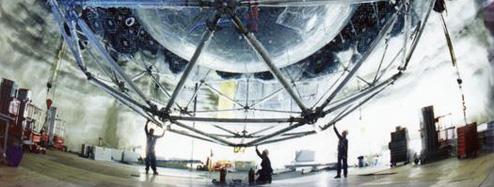
From Friday, October 19th to Sunday the 21st, about thirty-five theorists and experimentalists met at TRIUMF to discuss the physics of TeV-scale neutrinos...or was that the TeV-scale physics of neutrinos? The TeV-nu workshop, an inspiration of TRIUMF's John Ng, brought together phenomenologists with neutrino specialists -- both underground and long-baseline, collider enthusiasts, and partisans of low-energy electroweak precision measurements.
The neutrino is a weakly interacting, almost undetectable particle originally postulated by Pauli and Fermi to explain the apparent non-conservation of energy in nuclear beta decay. For decades, it was not known whether the neutrino had any mass at all. Attempts to measure its mass were the province of increasingly sensitive nuclear decay experiments, which showed that if neutrinos had any mass at all, it must be at least thousands of times smaller than the electron - the lightest measured elementary particle. Evidence for neutrino mass finally came from underground experiments designed to verify astrophysicists' model of interactions in the core of the sun. These culminated in the demonstration by the SuperKamiokande and Sudbury Neutrino Observatory (SNO) experiments that neutrinos could oscillate from one “flavour” (electron, muon or tau) to another. This could only be the case for massive neutrinos. The discovery of neutrino oscillations was astonishing, because it turns out that the mixing between muon- and tau-neutrinos is almost maximal; it had been expected that if neutrinos mixed, the mixings would be tiny as they are for quarks.
The discovery of neutrino mixing gave impetus to another set of experiments: the long-baseline reactor- and accelerator-based neutrino detectors, like T2K in Japan. These could be tailored to measure the individual mixing angles and mass-square differences. A new set of deep underground experiments (such as SNO+ and EXO) has been planned to look for neutrinoless double-beta decay, the elusive process whose existence would show conclusively that the neutrino is its own anti-particle.
It might appear that this leaves the high-energy collider experiments out in the cold. After all, the LHC and the TeVatron are designed to produce very massive objects, such as the top quark and the Higgs boson, millions of times more massive than electrons, and perhaps billions or trillions of times more massive than neutrinos. Weakly interacting neutrinos slip undetected through the vast bulk of the collider detectors; however, it should be remembered that the weak interaction is weak because the W and Z bosons which carry the weak force are so massive. Something which the workshop really brought home to the collider physicists was that the tiny masses of the neutrinos should send up a forest of red flags indicating the direction to look for the first hints of physics “beyond the Standard Model” at TeV colliders. The theorists told us about See-Saw models with massive “sterile” right-handed neutrinos, Higgs triplet models where the neutrino masses came from couplings to exotic, doubly-charged Higgs bosons: a host of possibilities, all with consequences for collider physics.
The workshop was a great opportunity for physicists representing all of these normally distinct communities to look for common ground and think about new aspects of their disciplines.
Banner photo: SNO Detector During Construction; Used by permission of SNOLAB.
